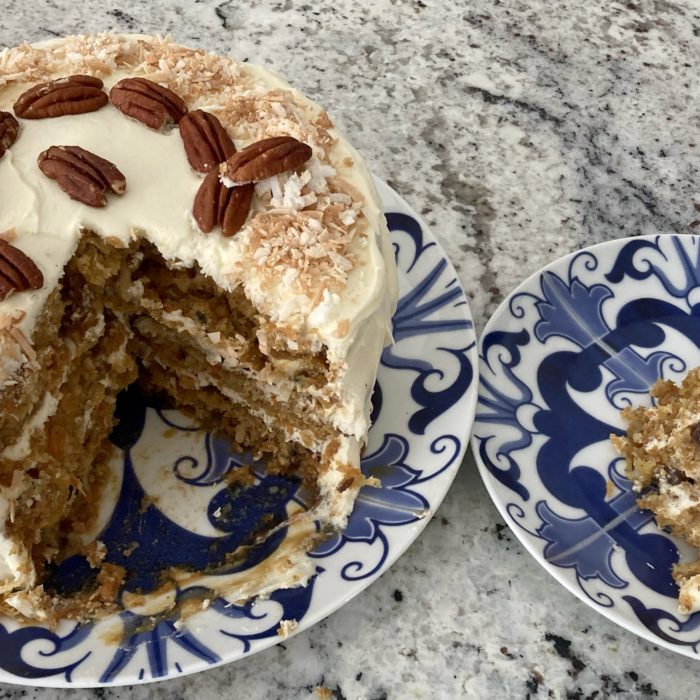
Carrot cake
I have officially found a better recipe for carrot cake,…
Eve's life, food and travels

I have officially found a better recipe for carrot cake,…
This is a sweet and crunchy Turkish/Greek dessert The challenge…
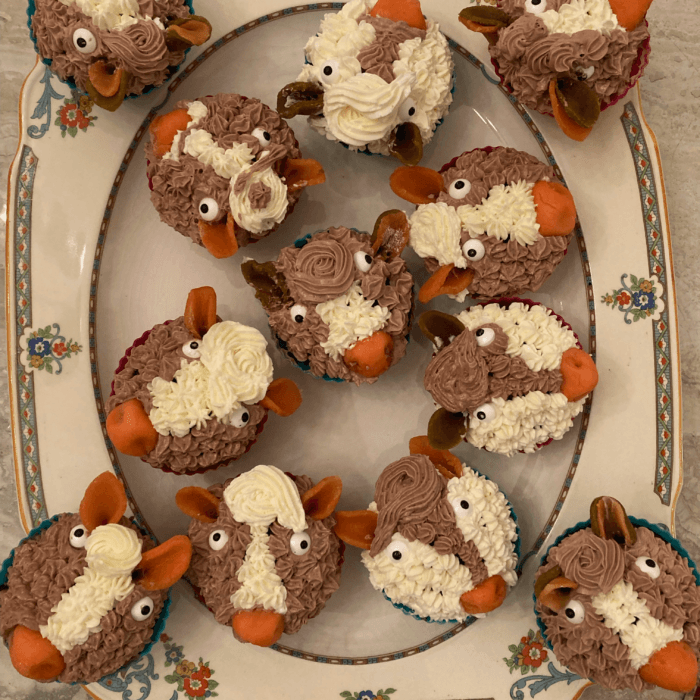
Chocolate cupcakes decorated with vanilla and chocolate buttercream

Chocolate cake with white butter cream frosting adorned with a…
Bakeware, like pots and pans, comes in many materials, the most common of which are aluminum, black steel, tinned steel, non-stick and glass. Many prefer heavy aluminum pans and baking sheets, as the aluminum conducts heat efficiently, the heavy weight prevents the pan from warping, and the material is easy to maintain. We suggest the following:
If a pan has four sides with rims, it’s called a jelly-roll pan, a baking pan, or a full- or half-sheet pan; if it has at least one rimless side, it’s a cookie sheet (when it’s not called a baking sheet). The rule of thumb is to buy the largest sheet that will fit into your oven while still allowing two inches of air space all around. Finally, think heavy. Both jelly-roll pans and baking sheets need to be truly heavy-duty since they’ll be subjected to heat high enough to corkscrew them if they’re not. Aluminum baking sheets are the best because they heat quickly and evenly, important stuff when you’ve got thin cookies in the oven. Avoid black-metal sheets and anything with a really dark coating: they can burn cookies quickly and will likely turn your treats brown before their time. A sticky issue involves nonstick coatings. I like having a few nonstick baking sheets in my cupboard. They’re great for tuiles and anything with lots of sugar and butter that might caramelise during baking and make cleanup a chore. But with few exceptions, I turn all of my baking sheets into nonstickers and easy clean-uppers by lining them with silicone-coated parchment paper before I bake. Parchment paper is a baker’s best friend. It’s naturally nonstick, makes even not-so-good baking sheets heat more evenly, and it can be wiped clean and used a couple of times before it gets tossed out.
Deciding on a diameter isn’t hard because most recipes specify that dimension, and most recipes specify an eight- or nine-inch-diameter pan. When it comes to choosing the height of the pan, a 1 1/2-inch-high pan is fine, but one that’s 2 inches high is better. Traditionally, aluminum was the metal of choice for layer-cake pans, and it’s still first-class because of its quick and even heatability. In the nonstick category, you’ve got plenty of choices, but they all come with the same recommendation: turn your oven down 25 degrees, and check for doneness about five minutes earlier than usual. They will retain their finish for years if you treat them kindly and don’t cut in them.
A pie dish is made of glass or ceramic; a pie pan, of metal. Unlike a tart pan, which is often made in France, associated with French pastries and possessed of militarily precise straight or sharply fluted sides. A pie dish has sides that flare outward. You can make a pie, sweet or savory, that has just a top crust, but that is often a deep-dish pie, with more filling than a regular one, and it’s best made in a deep-dish pie dish. Whereas the standard model has sides that are less than 1 1/2 inches high, a deep-disher has higher, straighter sides and, consequently, greater capacity. Because ovenproof glass conducts heat evenly, the Pyrex dish is particularly well suited for double-crusted pies that bake a long time. There are no hot spots, so a burned bottom is almost an impossibility. You can get similar usability in an often more attractive ceramic pie dish. Metal pans are best for open-face pies. Metal withstands high heat, and sets and browns crusts pronto. It’s this quick set that makes metal great for custard and cream pies, and pies that don’t have to spend a lot of time in the oven. (you’ve got to wash it by hand, take care not to scratch it, then dry it immediately so it won’t rust).
At its most basic, the springform pan is a two-piece affair. There’s a round base and an interlocking band, usually two to three inches high, that forms the sides, opening and closing with the flick of a latch. The pan pieces are assembled for baking, and then, once the contents have cooled, the band is opened and removed. Since a cake from a springform is rarely turned upside down to be unmolded, the top of the cake has a great chance of being unmarred. And because you have only to run a knife gently around the sides of the pan to separate cake from pan, the sides of your cake usually escape unscathed, too. Look for one with an extra deep groove in the base to catch drips. The only danger is to forget the bottom part of the pan at a hostess’s house when bringing the cake as a gift.
Here is what the experts say: don’t get caught pining for pins made of marble, they’re a drag on the dough, literally (although I enjoy mine…); or the shiny aluminum ones, they can turn a golden egg dough gray; or the type that gets filled with ice cubes, condensation forms on the pin, and the next thing you know, the dough is soggy. It seems that the French rolling pin is a good choice. It’s a uniform 2 inches across (no tapering) and weighs in at a pound and a quarter. It has ends that are gently rounded. There are no handles on this one. To clean, do not immerse in water and when you’re scraping, take care not to nick or, worse, gouge the wood; a smooth surface is key in a rolling pin. If you choose one with handles look for 5 inch handles and ball bearings.
Some say you need a whisk for every kind of pot you’ve got at home. For light-as-air whipped cream or meringue, reach for the “ballooningest” whisks; grab the narrower ones for stirring crème anglaise, reheating a soup or making a salad dressing; and use flat ones for gravy and getting into the corners of pots. Regardless of size, fluffing whisks need strong wires, which should be thin and plentiful. Whatever size or shape of whisk you buy, make sure the point at which the wires go into the handle is sealed so that you can keep the whisk as clean as a whistle. A nice bonus: sealed, all-stainless-steel whisks can be run through the dishwasher with no problem.
 This is pretty straightforward: various words, all related to food and cooking, listed alphabetically, and explained.
This is pretty straightforward: various words, all related to food and cooking, listed alphabetically, and explained.
There are also five illustrated techniques, four to show various methods of cutting different vegetables and one for preparing fruits.
Cooking in boiling water. You usually immerse the food in boiling water except in the case of soup bones where it is better to immerse the meat and bones in cold water and bring to a boil (it liberates more juices that way).
This consists, first in browning the meat in fat to form a nice crust on all sides. You then add vegetables and a small amount of liquid. You cook in the oven at low heat in a tightly shut casserole. Basting with cooking juices regularly. Whether used for lamb shanks or a stew, the technique is the same: fat is added to a pot or skillet, and then the meat is browned on all sides over high heat. Next, liquid is added; the mixture is then covered and cooked slowly until the meat is tender. Browning the meat adds flavour and colour, and the subsequent cooking in liquid keeps it moist. Because the meat is cooked in a closed pot for a long time, a rich sauce is produced. Braising is good for tougher cuts – the lengthy cooking process tenderises the meat.
To cook food directly under a radiant heat source. Depending on its thickness, meat or fish cooked in a broiler should be three to five inches from the heat source. The food should be placed on the broiler pan in a single layer, browned on one side, then turned with tongs (not a fork) so that no juices are lost.
 Thin strips of herbs or leafy vegetables are called chiffonade (from the word chiffon = rag). The strips make a pretty garnish, and sliced this way the leaves don’t get crushed or bruised. Stack several leaves, with the largest on the bottom, and roll them from one side to the other. Slice into ribbons.
Thin strips of herbs or leafy vegetables are called chiffonade (from the word chiffon = rag). The strips make a pretty garnish, and sliced this way the leaves don’t get crushed or bruised. Stack several leaves, with the largest on the bottom, and roll them from one side to the other. Slice into ribbons.
 Cut in half from top to bottom; slice off stem ends and remove skin. Make vertical cuts lengthwise, along the veins of the onion, without cutting through the root end – it holds the onion together as you work. Make a few horizontal cuts from cut edge to root end, then chop across onion, resulting in dice. To avoid tears cut near a flame (gas stove or votive candle), or near running water.
Cut in half from top to bottom; slice off stem ends and remove skin. Make vertical cuts lengthwise, along the veins of the onion, without cutting through the root end – it holds the onion together as you work. Make a few horizontal cuts from cut edge to root end, then chop across onion, resulting in dice. To avoid tears cut near a flame (gas stove or votive candle), or near running water.
To beat an ingredient or combination of ingredients until the mixture is soft, smooth and “creamy.” Often a recipe calls for creaming a fat, such as butter, or creaming a mixture of butter and sugar. When creaming two or more ingredients together, the result should be a smooth, homogeneous mixture that shows neither separation nor evidence of any particles (such as sugar). Electric mixers and food processors make quick work of what used to be a laborious, time-consuming process.
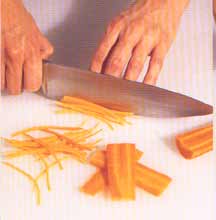 Vegetables for salads, stir fries, and garnishes are often julienned, or sliced into matchsticks. Start by cutting a vegetable into very thin slices. Stack several slices, and slice again. Cut the matchsticks into the length you need.
Vegetables for salads, stir fries, and garnishes are often julienned, or sliced into matchsticks. Start by cutting a vegetable into very thin slices. Stack several slices, and slice again. Cut the matchsticks into the length you need.
After food (usually meat) has been sautéed and the food and excess fat removed from the pan, deglazing is done by heating a small amount of liquid in the pan and stirring to loosen browned bits of food on the bottom. The liquid used is most often wine or stock. The resultant mixture often becomes a base for a sauce to accompany the food cooked in the pan.
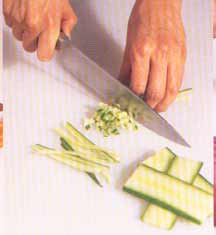 It’s essential that diced vegetables be uniform in size so they cook evenly – and look good too. Slice the vegetable very thin; stack several flat slices, and slice again very thin, into julienne. Gather several matchsticks and chop into equal-size cubes.
It’s essential that diced vegetables be uniform in size so they cook evenly – and look good too. Slice the vegetable very thin; stack several flat slices, and slice again very thin, into julienne. Gather several matchsticks and chop into equal-size cubes.
A mixture of one liquid with another with which it cannot normally combine smoothly, oil and water being the classic example. Emulsifying is done by slowly (sometimes drop-by-drop) adding one ingredient to another while at the same time mixing rapidly. This disperses and suspends minute droplets of one liquid throughout the other. Emulsified mixtures are usually thick and satiny in texture. Mayonnaise (an uncooked combination of oil, egg yolks and vinegar or lemon juice) and Hollandaise sauce (a cooked mixture of butter, egg yolks and vinegar or lemon juice) are two of the best-known emulsions.
Cooking in very hot oil or fat (200° to 500° F). The hotter the oil the less it will penetrate the food.
A thin, glossy coating for both hot and cold foods. A savory glaze might be a reduced meat stock or aspic whereas a sweet glaze could be anything from melted jelly to a chocolate coating. An egg wash brushed on pastry before baking to add colour and shine is also called a glaze. To coat food with a thin liquid (sweet or savory) that will be smooth and shiny after setting.
A popular Mexican specialty of mashed avocado mixed with lemon or lime juice and various seasonings (usually chili powder and red pepper). Sometimes finely chopped tomato, green onion and cilantro are added. Guacamole can be used as a dip, sauce, topping or side dish. It must be covered closely and tightly to prevent discolouration.
In cooking it is a thickening agent for soups, sauces and stews. Beurre manié, roux, egg yolks or starches such as flour, cornstarch and arrowroot are among those agents used for thickening. A liaison is sometimes also referred to as a binder. Remember that egg yolks must be tempered with hot liquid before adding to the liquid in order to prevent curdling.
A mixture of diced carrots, onions, celery and herbs sautéed in butter. Sometimes ham or bacon is added to the mix. Mirepoix is used to season sauces, soups and stews, as well as for a bed on which to braise foods, usually meats or fish.
The French word for a paper frill used to decorate the tips of rib bones, such as those on crown roasts. En papillote, refers to food baked inside a wrapping of greased parchment paper. As the food bakes and lets off steam, the parchment puffs up into a dome shape. At the table, the paper is slit and peeled back to reveal the food.
Cooking in a liquid that is just below boiling temperature. Poaching is a particularly effective method for cooking fish. Because it involves partially or completely submerging the food in a gently simmering liquid, it is nearly impossible to dry out even the leanest or most delicate fish. Foods can be poached in water, wine, stock or any combination of the three. To enhance the flavour of the liquid, herbs, spices, or other flavourings, such as lemon and garlic, can be added. The poaching liquid can be used as a light sauce. When the fish is opaque, simply remove it from the liquid and boil the liquid until reduced and the flavours intensify. Here is an unconventional approach that makes the technique even better: first, quickly sauté the fish to add colour and taste, and then poach it gently in a savory broth of white wine, clam juice, garlic, lemon and crushed red pepper. The result is perfectly cooked fish with wonderful flavour. The bonus: it is low in fat.
 Wash the fruit, and pat dry. Use a small, sharp paring knife or a vegetable peeler to pare off the skin in long, thin vertical strips. Pears are best peeled in this method. For apples, thinly peel all around the fruit in a spiral.
Wash the fruit, and pat dry. Use a small, sharp paring knife or a vegetable peeler to pare off the skin in long, thin vertical strips. Pears are best peeled in this method. For apples, thinly peel all around the fruit in a spiral.
 To core whole apples and pears, place the sharp edge of a corer over the stem of the fruit, press down firmly, then twist slightly; the core, complete with pips, will come away in the center of the corer. Push out the core from the handle end.
To core whole apples and pears, place the sharp edge of a corer over the stem of the fruit, press down firmly, then twist slightly; the core, complete with pips, will come away in the center of the corer. Push out the core from the handle end.
 Another way to core fruit is to halve the fruit lenghtways, the cut into quarters or segments. Carefully cut out the central core and pips, with a small sharp knife.
Another way to core fruit is to halve the fruit lenghtways, the cut into quarters or segments. Carefully cut out the central core and pips, with a small sharp knife.
 To peel citrus fruit: once you have removed all the bitter white pith that lies just beneath the rind of citrus fruits, use a small serrated knife to cut down in between the membranes enclosing the segments; cut along both sides at the base of the segment then carefully ease out the flesh of the fruit.
To peel citrus fruit: once you have removed all the bitter white pith that lies just beneath the rind of citrus fruits, use a small serrated knife to cut down in between the membranes enclosing the segments; cut along both sides at the base of the segment then carefully ease out the flesh of the fruit.
This type of cooking is done in a hermetically closing pot (presto). It is fast and conserves the nutritional value of food because it requires little water.
Culinarily, to boil a liquid (usually stock, wine or a sauce mixture) rapidly until the volume is reduced by evaporation, thereby thickening the consistency and intensifying the flavour. Such a mixture is sometimes referred to as a reduction.
A cooking term describing the texture of an egg-and-sugar mixture that has been beaten until pale and extremely thick. When the beater or whisk is lifted, the batter falls slowly back onto the surface of the mixture, forming a ribbonlike pattern that, after a few seconds, sinks back into the batter.
To cook food uncovered in a hot oven. To roast a chicken: leave it at room temperature 30 minutes before it is placed in the oven to ensure even cooking of the bird. When the chicken is ready to go into the oven, it is placed breast side down on a rack in a roasting pan. The rack prevents the chicken from stewing in its own juices, and the placement of the bird allows the juices from the fatty part of the chicken to run down into the leaner white meat of the breasts. After 30 minutes the chicken is turned breast side up by inserting a large kitchen fork into the main cavity. If the skin is pricked, some of the juices may be lost.
To cook in a small amount butter or oil (or a mixture of both) to colour the food. Usually using a skillet or a saucepan over high heat and with a movement of turning the meat in the pan (hence the word sauté which means to jump in french). When chopped items are cooked, the pan is left uncovered and the mixture inside is stirred until brown on all sides. When larger pieces, like chops or steaks, are sautéed, they are cooked uncovered until brown on both sides. Then the heat is lowered, the pan is sometimes covered, and the meat is cooked to the desired doneness. The mixture left behind in the pan can contribute to a sauce: the meat is removed, some liquid is added and brought to a boil, and any browned bits in the pan are stirred up. Then the mixture is reduced to a sauce consistency.
To separate an egg, crack the egg on the edge of a bowl and open it up over a smaller bowl, holding the larger half-shell beneath the smaller one. Carefully let the yolk settle into the lower shell. As you do this, the white will spill out into the bowl below. Transferring the yolk to the smaller half of the shell, let the rest of the white spill into the bowl. Transfer the yolk one more time, then place the yolk into a separate bowl. It’s a good idea to separate eggs one at a time into a small bowl and then transfer the separated egg into a larger bowl. This way, if some shell or yolk should fall into the white, it is easier to remove it. This is important, because if you’re going to whip the whites, any fat from the yolks will prevent proper aeration. If you have a lot of eggs to separate, try this: Simply pour the cracked egg into your hand and let the white slip between your fingers into the bowl. The yolk remains behind.
This requires the use of a “bain marie” that would have a pierced upper part or a steam flower (or folding vegetable steamer). You cover the whole thing with a lid so as to keep the steam inside. Be careful that the water does not touch the food (or it would be boiling) yet there must always be enough to avoid scorching the pot. You can add spices or herbs to the cooking water.
A technique by which ingredients, particularly vegetables, are cooked in a small amount of fat over low heat. The ingredients are covered directly with a piece of foil or parchment paper, then the pot is tightly covered. With this method, the ingredients soften without browning, and cook in their own juices.
Popular throughout Spain in bars and restaurants, TapasÊare appetizers that usually accompany Sherry or other Apéritifs or Cocktails. They can also form an entire meal and can range from simple items such as olives or cubes of ham and cheese to more elaborate preparations like cold omelets, snails in a spicy sauce, stuffed peppers and miniature sandwiches. To me they are synonymous with shrimps, mountains of shrimps eaten standing at a bar in the south of Spain…
French for “tile”, a tuile is a thin, crisp cookie that is placed over a rounded object (like a rolling pin) while still hot from the oven. Once cooled and stiff, the cookie resembles a curved roof tile. The classic tuile is made with crushed almonds but the cookie can also be flavored with orange, lemon, vanilla or other nuts.
When the pot containing the food is put into or over another larger pot containing very hot water (double boiler). This can be done on the stovetop or in the oven. It is used for delicate preparations that cannot withstand high heat (egg or cream based sauces and chocolate).
The perfumy outermost skin layer (rind) of citrus fruit (usually oranges or lemons), which is removed with the aid of a citrus zester paring knife or vegetable peeler. Only the coloured portion of the skin (and not the white pith) is considered the zest. The aromatic oils in citrus zest are what add so much flavour to food. Zest can be used to flavour raw or cooked and sweet or savory dishes.
I had been wanting to go on a Rhine river cruise ever since I did a Danube cruise a few years back. I wanted to see the castles along the way, visit Cologne and its…
This was an exciting trip both because of the itinerary: visiting St Petersburg has always been a dream of mine! and because of the ship: we were sailing with Oceania, which is a very high-end…
Like a lot of people I had visited Mexico’s coasts: the Riviera Maya on the Caribbean side and Acapulco and Puerto Vallarta on the Pacific one. But I had never visited Mexico city, and, more…
Iceland was quickly becoming a popular destination. I had heard raving reviews of it and was looking for an opportunity to visit for myself. A cruise to Iceland came up that sounded intriguing. It was…
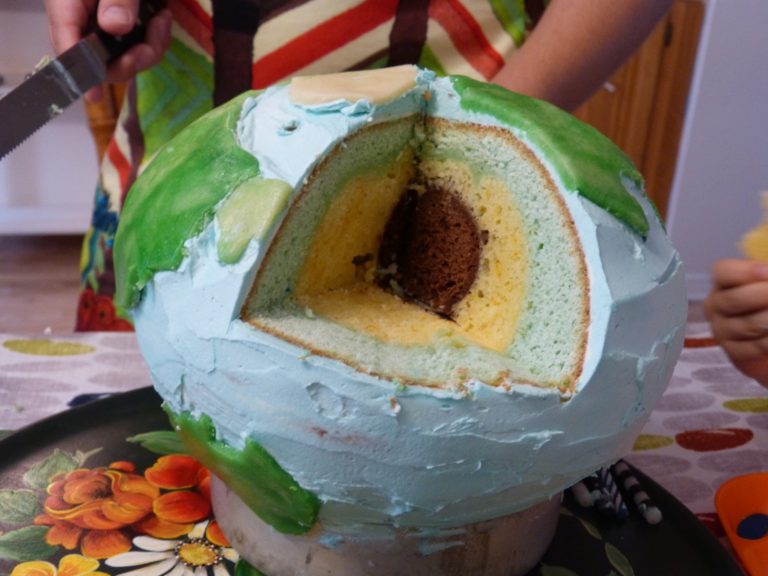
My first attempt at reproducing the globe inside and out…

It is with some delay that I finally posted the…

I was back in Florida again this year and, as…

To conclude my nature discoveries I will include photos of…